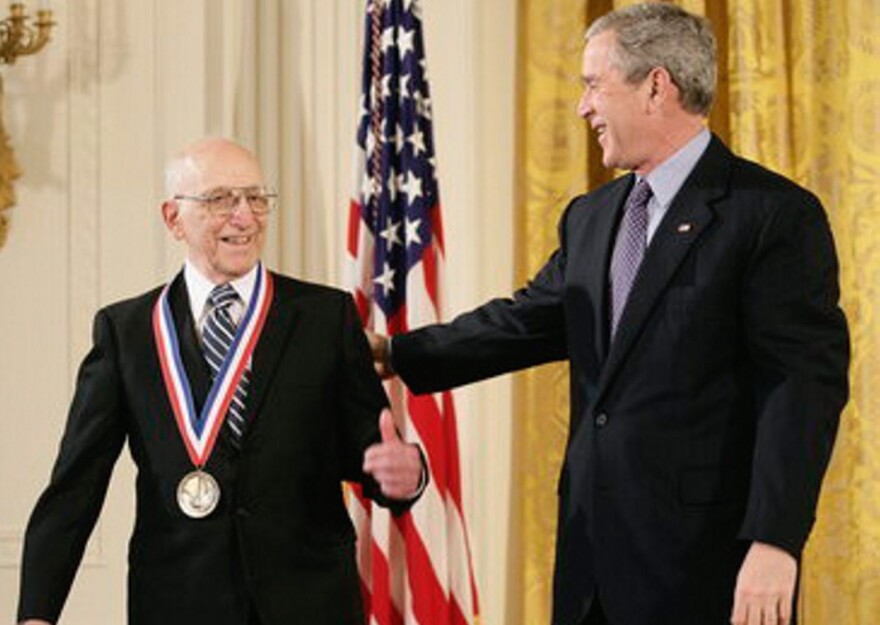If you grew up in the 1970s or 80s, the sound of Simon may be familiar to you. It’s the electronic memory game that gives you increasingly difficult patterns of sounds and colors to remember and repeat.
Some of the credit for inventing it goes to late Manchester resident Ralph Baer. Baer was part of a team that developed the first home video game in the late 1960s'. The National Museum of American History in Washington D.C. has included Baer’s Manchester, N.H. workshop as part of its innovation wing.
David Brooks of the the Nashua Telegraph and Granitegeek.org spoke with NHPR’s Peter Biello about the new exhibit.
It’s a pretty big honor to have your workshop reproduced in a Smithsonian museum. Baer did much more than just help invent Simon.
He did. He had a lot of honors. He received the National Medal of Technology from President George W. Bush. He was in the National Inventors Hall of Fame. And he was really well-known, almost revered in the online gaming community, specifically because, when he was an engineer at Sanders Associates, which is now BAE Systems in Nashua, part of his work—kind of on the side—he led a team of engineers and they developed the first home video game which was eventually sold as Magnavox Odyssey. It was Pong, a version of Pong that you could play on your TV set and a couple of other things. So these are old time TV sets in which the cathode ray tube that fires the stream of electrons at the back of the screen and causes a glow when it hits, and the stream of electrons is moved by the magnetic fields, and that’s how you make a TV picture. The big insight his team had was that they could make electronics that could allow people watching the TV set to move that stream of electrons around as well. They developed Pong, a shooting game with a gun—all sorts of things you could do with a TV set. It was recognized as the first home video game.
You interviewed Baer a few times. What was he like?
He was a character. He was a great guy. I didn’t meet him until he was already in his seventies, inventing right up until the very end. When I talked to the folks at the National Museum of American History, they came and talked to him about taking his workshop and his concern was he wouldn’t have anywhere to work, so he built another workshop in his bedroom. Even when he was getting quite sick, he never really stopped. When I first met him, he was working on an electronic bicycle noisemaker, so that you could make your bike sound like a Harley Davidson.
Part of his story is that his family was Jewish, living in Germany, and fled the rise of the Nazis in the 1930s, and he arrived in the US as a young boy, became an American citizen and lived here all his life. He was a television technician before he became an engineer and ended up at Sanders Associates. He had a different viewpoint of TVs from the other guys he was around.
What will the exhibit at the museum consist of?
They specifically came and took his workshop. He lived in a small—not small, but modest, home in North Manchester. Nothing grandiose by any means. It was in a long basement with wood panel walls and frankly, you walk in and—if you’re my age—it reminds you of the house you grew up in in the 1960s. And in one end he had a workshop, and he put a fake brick exterior wall with a window in it and a door, so when you entered his workshop, it was like you were entering a whole different building, like a little house. It was sort of a joke he had. They came and took the whole workshop—the desk, the books, and the oscilloscope and soldering iron and all the stuff any electrical engineer or inventor would recognize and manuals and old magazines and his jacket. They even took the mailbox and the flower box outside the window with fake flowers in it. They took that, too, and they set it all up, recreated it inside a big glass case in the museum. It’s on the first floor of their new wing, which was as you mentioned all about innovation. The whole idea was: this is a place where innovation occurred, and many inventors have similar spaces, they have somewhere they can go to tinker and make mistakes and burn their fingers and this was his.
And is the museum pushing this idea that innovation can happen anywhere—it just depends on whether you have the will to invent something?
Yes, exactly. It can even happen in a place with plastic flowers outside a fake wall. It’s a very American story, particularly because, obviously, he was someone who chose to be an American who came here and decided to stay and did really interesting, different things, partly through force of personality and through hard work and brains and experimentation.







